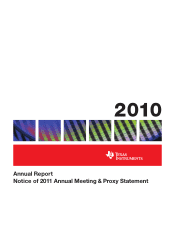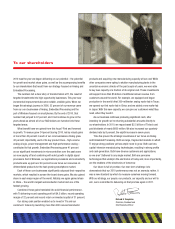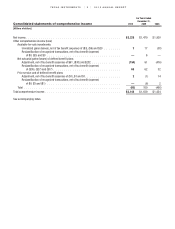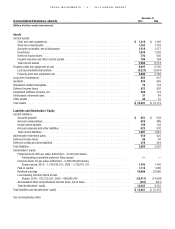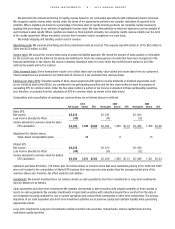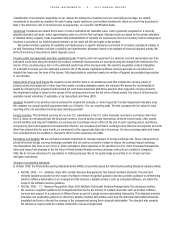Texas Instruments 2010 Annual Report Download - page 11
Download and view the complete annual report
Please find page 11 of the 2010 Texas Instruments annual report below. You can navigate through the pages in the report by either clicking on the pages listed below, or by using the keyword search tool below to find specific information within the annual report.
TEXAS INSTRUMENTS 2010 ANNUAL REPORT
9
| |
Classification of investments: Depending on our reasons for holding the investment and our ownership percentage, we classify
investments in securities as available-for-sale, trading, equity-method or cost-method investments, which are more fully described in
Note 7. We determine cost or amortized cost, as appropriate, on a specific identification basis.
Inventories: Inventories are stated at the lower of cost or estimated net realizable value. Cost is generally computed on a currently
adjusted standard cost basis, which approximates costs on a first-in first-out basis. Standard costs are based on the normal utilization
of installed factory capacity. Costs associated with underutilization of capacity are expensed as incurred. Inventory held at consignment
locations is included in our finished goods inventory, as we retain full title and rights to the product.
We review inventory quarterly for salability and obsolescence. A specific allowance is provided for inventory considered unlikely to
be sold. Remaining inventory includes a salability and obsolescence allowance based on an analysis of historical disposal activity. We
write off inventory in the period in which disposal occurs.
Property, plant and equipment and other capitalized costs: Property, plant and equipment are stated at cost and depreciated over their
estimated useful lives using the straight-line method. Leasehold improvements are amortized using the straight-line method over the
shorter of the remaining lease term or the estimated useful lives of the improvements. We amortize acquisition-related intangibles
on a straight-line basis over the estimated economic life of the assets. Capitalized software licenses generally are amortized on a
straight-line basis over the term of the license. Fully depreciated or amortized assets are written off against accumulated depreciation
or amortization.
Impairments of long-lived assets: We regularly review whether facts or circumstances exist that indicate the carrying values of
property, plant and equipment or other long-lived assets, including intangible assets, are impaired. We assess the recoverability of
assets by comparing the projected undiscounted net cash flows associated with those assets to their respective carrying amounts.
Any impairment charge is based on the excess of the carrying amount over the fair value of those assets. Fair value is determined by
available market valuations, if applicable, or by discounted cash flows (DCF).
Goodwill: Goodwill is not amortized but is reviewed for impairment annually, or more frequently if certain impairment indicators arise.
We complete our annual goodwill impairment tests as of October 1 for our reporting units. The test compares the fair value for each
reporting unit to its associated carrying value including goodwill.
Foreign currency: The functional currency for our non-U.S. subsidiaries is the U.S. dollar. Accounts recorded in currencies other than
the U.S. dollar are remeasured into the functional currency. Current assets (except inventories), deferred income taxes, other assets,
current liabilities and long-term liabilities are remeasured at exchange rates in effect at the end of each reporting period. Inventories,
and property, plant and equipment and depreciation thereon, are remeasured at historic exchange rates. Revenue and expense accounts
other than depreciation for each month are remeasured at the appropriate daily rate of exchange. Currency exchange gains and losses
from remeasurement are credited or charged to Other income (expense) net (OI&E).
Derivatives and hedging: We use derivative financial instruments to manage exposure to foreign exchange risk. These instruments are
primarily forward foreign currency exchange contracts that are used as economic hedges to reduce the earnings impact exchange
rate fluctuations may have on our non-U.S. dollar net balance sheet exposures or for specified non-U.S. dollar forecasted transactions.
Gains and losses from changes in the fair value of these forward foreign currency exchange contracts are credited or charged to
OI&E. We do not use derivatives for speculative or trading purposes. We do not apply hedge accounting to our foreign currency
derivative instruments.
Changes in accounting standards:
In October 2009, the Financial Accounting Standards Board (FASB) concurrently issued the following Accounting Standards Updates (ASUs):
• ASUNo.2009–14-Software (Topic 985): Certain Revenue Arrangements That Include Software Elements. This standard
removes tangible products from the scope of software revenue recognition guidance and also provides guidance on determining
whether software deliverables in an arrangement that includes a tangible product, such as embedded software, are within the
scope of the software revenue guidance.
• ASUNo.2009–13-Revenue Recognition (Topic 605): Multiple-Deliverable Revenue Arrangements. This standard modifies
the revenue recognition guidance for arrangements that involve the delivery of multiple elements, such as product, software,
services and support, to a customer at different times as part of a single revenue generating transaction. This standard provides
principles and application guidance to determine whether multiple deliverables exist, how the individual deliverables should be
separated and how to allocate the revenue in the arrangement among those separate deliverables. The standard also expands
the disclosure requirements for multiple deliverable revenue arrangements.

